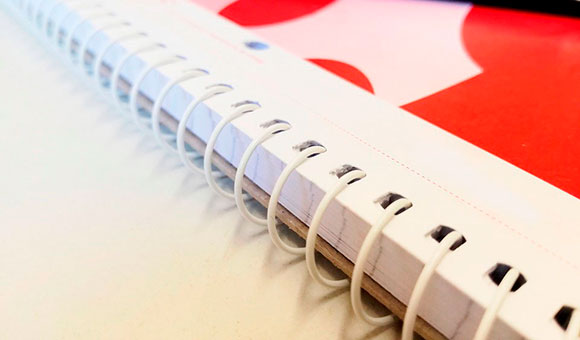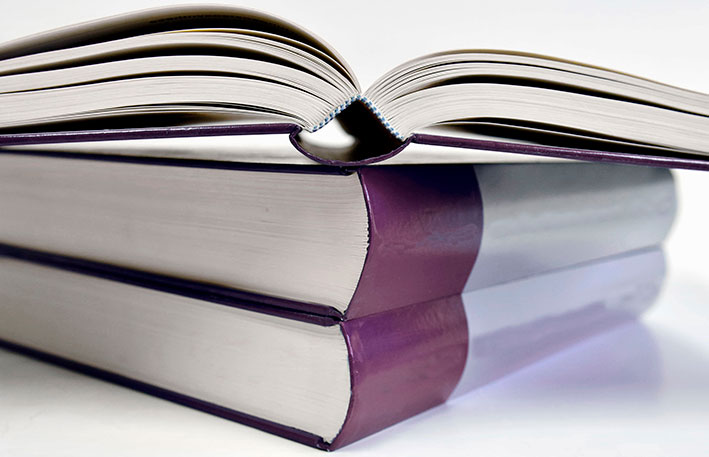Types of binding
Not sure how to bind your written work? PCG helps you choose the most appropriate binding method and introduces you to the most conventional types.
Binding means gathering printed sheets together in order to preserve them, facilitate their use and make them look more presentable. To choose the best binding option you have to take into account the quality of the paper, the number of sheets, the final size of the product and its use. We will define the most common types, some are cheaper and faster and others are more expensive and slower to produce.

Stapled
(“Saddle Stitching”)
Use: catalogues, rates, magazines, newspapers, technical manuals, etc.
The most economical and fastest to produce. Metal threads or staples are used to gather the sheets printed on both sides, folded in half and piled on top of each other. It is used for small amounts of pages, from 8 up to 40 approximately, depending on the grammage and type of paper.
There is another stapling technique in which omega Ω staples are used, their shape is convenient because it allows inserting the stapled document into a ring binder.
Coil binding or wire-o
Use: books, catalogues, diaries, notebooks, class work, etc.
It consists of piling up the sheets of paper in blocks, then perforating them on the side of the spine and placing a spiral or a wire-o.
Its most remarkable features are the possibility of turning its pages 360º, it is also an economical and fast technique, but not as much as stapling. The holes are different for wire-o and coil binding and the diameter of the rings varies according to the number of sheets.
Unlike coil binding, wire-o uses a double wire, which offers greater strength and is aesthetically more pleasing. Wire-o is placed in holes that were previously made and then closed.

Coil Binding

Wire-o binding
Paperback
(“Softcover”)
Use: softcover books. Catalogues of products or rates, manuals, books as novels or essays.
There are two kinds:
Perfect bound: the sheets are piled up in a block that will form the inside, the spine is milled, which consists in cutting small indentations in the paper to help the glue penetrate better and thus bind the sheets to each other and to the cover more strongly.
Perfect binding that uses PUR glue is much more resistant than the conventional one made with EVA glue, it has more density and achieves a greater durability of the binding.
Section sewn: uncut sheets (printed pages produced by folding a sheet of paper several times) are gathered following the pagination order and sewn together. Then hot glue is applied on the spine to stick it to the cover and the three remaining sides are cut resulting in the final product. Being sewn makes the binding more resistant and of higher quality than perfect bound but also more expensive.


Hard cover
Use: quality books.
It uses the same technique as paperback but with the only difference that the cover is hard.
The later is formed with three pieces of stiff cardboard, one for the front cover, another of the same size for the back cover and a thinner one for the spine. These three elements are covered with a printed paper lining that can be matte or glossy and laminated for durability. The inner part of the covers are covered with paper (guards) to attach the cover to the inside pages.
Contact with PCG
If you need a personalised quotation or would like our team to provide you with assessment for your projects, please feel free to contact us. We are a team of professionals from the sector that will look after your project from beginning to end.
